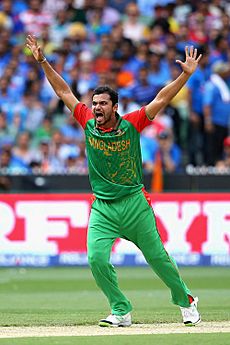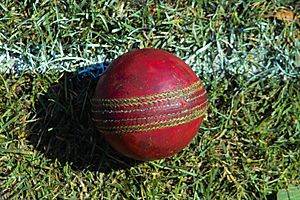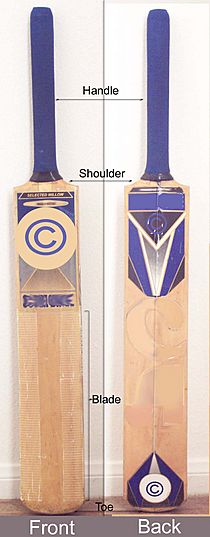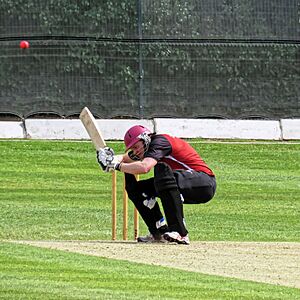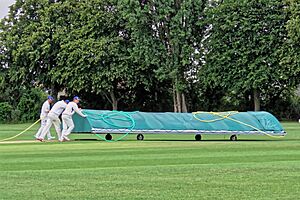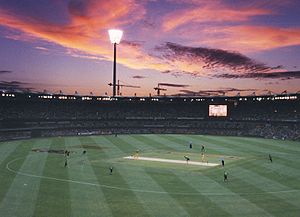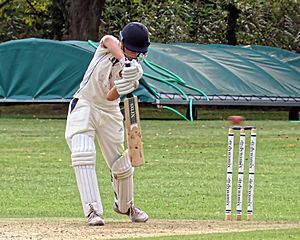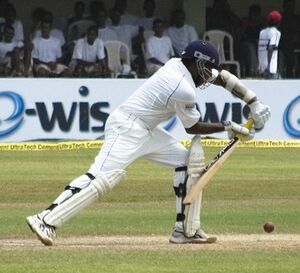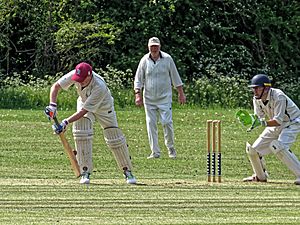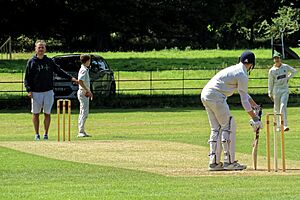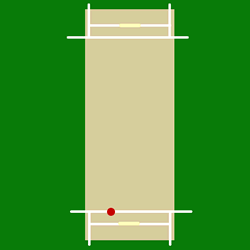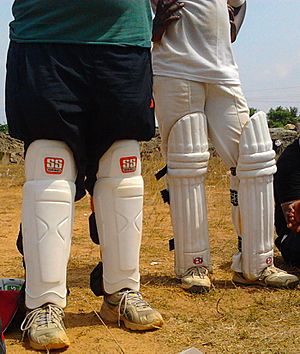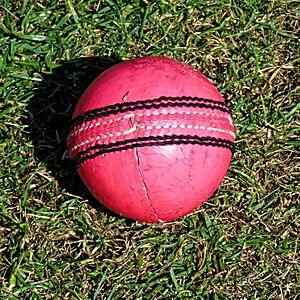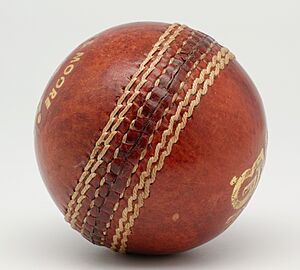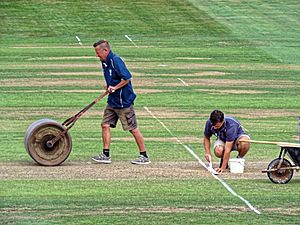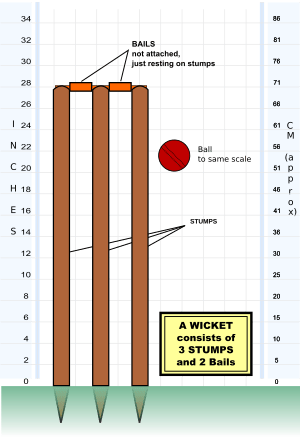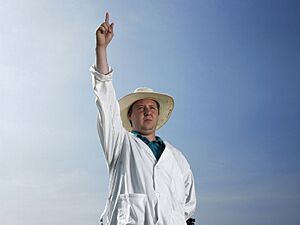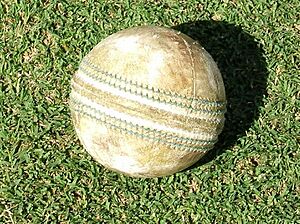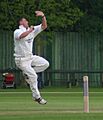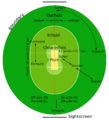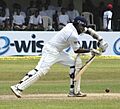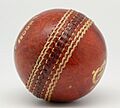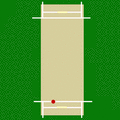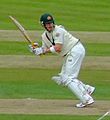Glossary of cricket terms facts for kids
Cricket is a super exciting sport played with a bat and ball between two teams. It's known for its unique words and phrases, which can sometimes sound a bit funny or confusing if you're new to the game! This guide will help you understand some of the most common terms used in cricket.
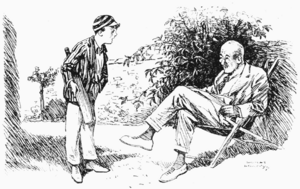
Father. "Yes, but how did you get out? Were you caught, stumped or bowled, or what?"
Cartoon from Punch, 21 July 1920.
| Top - 0-9 A B C D E F G H I J K L M N O P Q R S T U V W X Y Z |
Cricket Words from A to Z
Across the Line
This is a shot where the batter swings the bat sideways, not straight. It's used when aiming for square or behind square. It needs great timing and can be risky.
Action
This refers to a bowler's bowling action, which is how they move their body when they bowl the ball.
Agricultural Shot
A very powerful slog shot hit across the line. It's played with little skill and can even damage the pitch. The ball often goes to cow corner.
Air
When a spin bowler delivers the ball with a higher path than usual. This is also called flight. It can trick the batter about where the ball will land.
All Out
An innings ends when a batting team is all out. This usually means ten of the eleven batters have been dismissed. One batter is always left not out.
All-rounder
A player who is good at both batting and bowling. Some also consider a wicket-keeper-batter an all-rounder.
Appeal
When a bowler or fielder asks the umpire to dismiss the batter. They usually shout 'howzat!' (how's that?). The umpire must be asked to give a batter out.
Arm Ball
A special delivery by a finger spinner that looks like their normal stock ball but doesn't spin. It goes straight, following the bowler's arm.
Around the Wicket
When a bowler runs up to bowl on the side of the stumps that is further from the batter. It's the opposite of over the wicket.
The Ashes
This is a famous trophy for the Test match series between England and Australia. It started in 1882 after Australia beat England for the first time in England. A newspaper joked that English cricket had died and its ashes would be taken to Australia.
Asking Rate
See required run rate.
Attacking Field
A way to set up fielders where many are placed close to the pitch. This helps them catch the ball and get wickets, but it also means more runs might be scored.
Attacking Shot
A strong hit by the batter that is meant to score runs.
Average
This can mean a batting average (how many runs a batter scores on average) or a bowling average (how many runs a bowler gives up for each wicket they take).
Back Foot
When batting, it's the foot closest to the stumps. When bowling, it's the foot that lands before the front foot.
Back Foot Shot
A shot played by the batter with their weight on their back foot. It's often used when hitting the ball behind square.
Back Spin
A delivery that spins backward. After it bounces, the ball slows down or bounces lower and slides towards the batter.
Backing Up
- When the non-striking batter leaves their crease early to be ready to run. If they go too far, they risk being run out.
- When a fielder stands behind a teammate who is throwing the ball at the stumps. This helps stop overthrows if the throw misses.
Backlift
Lifting the bat up before hitting the ball.
Bad Light
When the umpires stop play because it's too dark to see the ball safely.
Baggy Green
A famous green cricket cap worn by Australian Test cricketers. It's a symbol of national pride.
Bail
One of the two small pieces of wood that sit on top of the stumps.
Ball
- The round object the bowler bowls to the batter. It's made of leather around a cork center. Red balls are for timed matches, and white balls are for limited overs games.
- A single delivery by a bowler. An over has six balls.
Ball Tampering
Illegally changing the ball's condition, usually by a fielder, to make it swing more. This is a form of cheating.
Ball Tracking
A computer system that tracks the ball's path. It's used by the third umpire for LBW decisions and by commentators to analyze play.
Bang (it) In
To bowl a delivery shorter and with more speed and force.
Bat
The wooden tool the batter uses to hit the ball. It has a flat blade and a round handle.
Bat-Pad
A fielder placed very close to the batter on the leg side. They try to catch the ball if it hits the bat and then the pad.
Batter
A player on the batting team. Two batters are always on the pitch at a time. The term 'batter' is now used instead of 'batsman' or 'batswoman'.
Batting
The skill of defending your wicket and scoring runs.
Batting Average
The average number of runs a batter scores each innings. It's calculated by dividing total runs by the number of times they were out.
Batting Collapse
When a team loses many wickets quickly for very few runs.
Batting for a Draw
When a team in a timed match tries to avoid losing by batting very defensively. They focus on staying in rather than scoring runs.
Batting Order
The order in which batters come to bat. It goes from openers to the top order, middle order, and lower order.
Beamer
An illegal delivery that reaches the batter above their waist without bouncing. It's an automatic no-ball.
Beat the Bat
When a batter just misses hitting the ball with the edge of their bat. It's seen as a small win for the bowler.
Beehive
A diagram showing where a bowler's deliveries passed the batter.
Belter
A pitch that is very good for batting.
Bend the Back
When a pace bowler puts in extra effort to bowl with more speed or bounce.
Best Bowling
A bowler's best performance in terms of wickets taken and runs given up.
Biffer
A slang term for an attacking batter who hits the ball hard.
Bite
The amount of turn a spin bowler can get from the pitch.
Block
A defensive shot meant to stop the ball safely without scoring runs.
Blocker
A slang term for a defensive batter who scores slowly. The opposite of a biffer.
Block Hole
The space between the bottom of the bat and the batter's toes. This is where a yorker is aimed.
Bodyline
A historical tactic where fast bowlers aimed at the batter's body with many fielders on the leg side. It was very controversial and led to rule changes.
Boot Hill
Another name for short leg, a dangerous fielding position close to the batter.
Bosie
See googly.
Bottom Hand
The batter's hand closest to the bat's blade. Shots played with the bottom hand often go high in the air.
Bouncer
A fast, short-pitched delivery that bounces up high, near the batter's head.
Boundary
- The edge of the field.
- A rope marking the edge of the field.
- A shot that reaches or crosses the boundary rope. If it bounces first, it's four runs. If it doesn't bounce, it's six runs.
Bowled
A way a batter can be dismissed. It happens when the ball hits the stumps and knocks off at least one bail.
Bowled Around the Legs
When a batter is bowled by a delivery that passes on their leg side before hitting the wicket.
Bowled Out
See all out.
Bowler
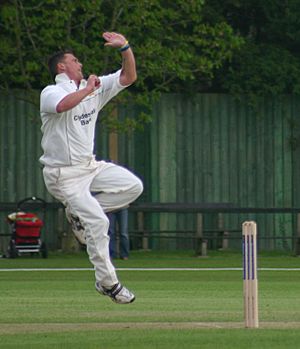
- The player who is currently bowling.
- A player who is very good at bowling.
Bowling
The act of delivering the cricket ball to the batter.
Bowling Action
The movements a bowler makes when delivering the ball.
Bowling Analysis
A summary of a bowler's performance, showing overs, maidens, runs given up, and wickets taken.
Bowling Average
The average number of runs a bowler gives up for each wicket they take. Lower is better.
Box
A protective cup worn by batters and wicket-keepers to protect them from the hard ball.
Brace
Two wickets taken off two balls in a row.
Break
This means the ball changes direction after bouncing, usually because of spin or cut. For example, a leg spinner bowls leg breaks.
Bump Ball
A ball that hits the bat and then immediately bounces into the ground before being caught by a fielder. It can look like a clean catch.
Bunsen
A pitch where spin bowlers can make the ball turn a lot.
Bye
Extra runs scored when the ball doesn't touch the batter's bat or body.
Cafeteria Bowling
Poor bowling that is easy for batters to hit and score runs from.
Call
- A shout by a fielder (like "mine") to say they are going for a catch.
- A shout by a batter to their partner (like "yes" or "no") to decide if they should run.
Cap
[[multiple image|width=thumb|direction=vertical|image1=2017–18 W Ashes A v E Test 17-11-11 Ecclestone's cap (01).jpg|image2=2017–18 W Ashes A v E Test 17-11-10 Perry portrait (02).jpg|footer=Two examples of cricket caps: the blue cap of England and the baggy green of Australia]]
- A soft hat worn by fielders.
- An appearance for a national team.
Captain
The leader of the team. The captain makes important decisions like who bowls, where fielders stand, and when to declare.
Carrom Ball
A type of spin bowling delivery where the ball is flicked with the thumb and middle finger to make it spin.
Carry
- When a shot is hit in the air and reaches a fielder without bouncing.
- How far a delivery bounces through to the wicketkeeper if the batter doesn't hit it.
Carry the Bat
When an opener bats through the entire innings and remains not out. It's a great achievement.
Castled
When a batter is clean bowled, usually by a yorker or a full length ball.
Catch
When a fielder gets full control of the ball in their hands before it touches the ground. If they do, the batter is caught out.
Caught
A way a batter can be dismissed. A fielder (including the bowler) catches the ball after the batter hits it, before it touches the ground. This is the most common way to get out.
Caught and Bowled
When the bowler catches the ball to dismiss the batter.
Caught Behind
When the wicket-keeper catches the ball to dismiss the batter, usually from a slight edge.
Centurion
A player who has scored a century.
Century
A score of 100 runs or more by one batter. It's a big personal achievement.
Chance
An opportunity for the fielding team to dismiss a batter that they miss. For example, a dropped catch or a missed run out.
Charge
When a batter moves quickly towards the bowler while the ball is in flight to hit a powerful shot.
Check Upstairs
To ask the third umpire to review a decision using the Umpire Decision Review System.
Cherry
A slang term for a red ball.
Chin Music
When pace bowlers bowl a lot of bouncers to try and scare the batter.
Chinaman
See left-arm unorthodox spin.
Chop On
When a batter is bowled because the ball hits the inside or bottom edge of their bat and then bounces onto the stumps.
Chuck
When a bowler illegally throws the ball by bending their elbow. This is against the rules.
Circle
A painted circle on the field, 30 yards (27 meters) from the pitch. It separates the infield from the outfield and is used for fielding rules in limited overs games.
Clean Bowled
When a batter is bowled without the ball touching their bat or pad first.
Club
- A group of cricketers who form one or more teams.
- To hit the ball hard but without much skill.
Club Cricket
Organized cricket played by skilled amateur players. It's a higher standard than village cricket but not professional.
Collapse
See batting collapse.
Come to the Crease
When a batter walks onto the field to start batting.
Conventional Swing
See swing.
Corridor of Uncertainty
A narrow area just outside the batter's off stump. Deliveries here are hard for the batter to decide whether to hit or leave.
County Cricket
The highest level of domestic cricket in England and Wales.
Cover
- A fielding position on the off side.
- A waterproof sheet used to protect the pitch from rain.
Cow Corner
An area of the field between deep mid-wicket and long-on. Few normal shots are aimed here, so there are usually no fielders.
Cow Shot
A hard shot, usually in the air, hit across the line towards cow corner. It's a type of slog.
Crease
White lines painted on the pitch near the stumps. They help decide if a run is scored or if a batter is run out.
Cricketer
A person who plays cricket.
Cross-Bat Shot
A shot played with the bat held flat, parallel to the ground, like a cut or a pull.
Cut
A shot played square on the off side to a short-pitched delivery that is wide of the off stump. The batter makes a "cutting" motion.
Cutter
A break delivery bowled by a fast or medium-pace bowler. It spins like a spin bowler's ball but is faster.
Daddy Hundred
An informal term for a batter's score much higher than a century, usually 150 runs or more.
Daisy Cutter
- A low-bouncing delivery that bounces twice or rolls along the ground. It's a type of no ball.
- A shot where the ball travels low, just above the grass, making it hard to catch.
Dance Down
When a batter moves closer to the bowler while the ball is in flight to change where it lands. It's less aggressive than a charge.
Day/Night Match
A cricket match that starts in the day and ends after sunset, using floodlights.
Dead Ball
- The time between deliveries when batters can't score runs or get out.
- A signal from the umpire to show play has stopped.
Dead Bat
A defensive shot where the bat is held loosely and angled down. This makes the ball lose speed and drop quickly, reducing the chance of being caught.
Death Bowler
A bowler who is good at bowling in the death overs at the end of a limited overs match. They use special variations to stop batters from scoring fast.
Death Overs
The last few overs of an innings in a limited overs match. Batters hit very aggressively here to score runs quickly.
Death Rattle
The sound the ball makes when it hits the stumps and knocks off the bails for a bowled dismissal.
Declaration
When a captain decides to end their team's innings early, usually in timed matches, because they think they have enough runs to win.
Deep
Describes a fielding position that is further away from the batter, closer to the boundary.
Defensive Field
A fielding setup where fielders are spread out to stop runs and boundaries, even if it means fewer chances to take catches.
Delivery
The act of bowling the ball.
Devil's Number
A score of 87, considered unlucky in Australian cricket because it's 13 runs short of a century.
Diamond Duck
When a batter is dismissed for zero runs without even facing a ball, usually by being run out.
Dibbly Dobbly
- A medium pace delivery that is neither fast nor slow, with no special spin.
- A bowler who bowls this type of delivery.
Dink
A gentle shot played by a batter to guide the ball into an empty area of the field, using the ball's own speed.
Dipper
A delivery that curves into or away from the batter before bouncing.
Dismissal
When a batter is out and must stop batting for the rest of the innings. There are ten ways to get out, but most are caught, bowled, leg before wicket, run out, or stumped.
Direct Hit
When a fielder's throw hits the stumps directly, without another fielder touching it first, to try for a run out.
Doctored Pitch
A cricket pitch that has been specially prepared to help the home team, for example, by making it good for spin bowlers. This is seen as unsporting.
Dolly
A very easy catch.
Doosra
A special delivery by a finger spin bowler that spins the opposite way to their normal stock delivery.
Dot Ball
A delivery from which no runs are scored. It's marked with a dot in the scorebook.
Double
When a player scores 1000 runs and takes 100 wickets in the same season.
Down the Pitch
When a batter moves towards the bowler to hit the ball, hoping to turn a good length ball into a half-volley.
Draw
- A result in timed matches where the team batting last doesn't get all out but also doesn't score enough runs to win.
- An old shot that is no longer used.
Draw Stumps
To end the game, or a day's play, by taking the stumps out of the ground.
Drift
The slight sideways curve a spinner gets on the ball while it's in the air. It makes it harder for the batter to judge the ball.
Drinks
A short break in play when refreshments are brought out to the players.
Drive
A shot played with a straight bat on the front foot, usually to score runs. It's often considered a very nice-looking shot.
Drop
- When a fielder fails to hold onto a catch. The batter is then "dropped".
- The number of wickets that have fallen before a batter comes in to bat.
- To remove a player from the team.
Drop-in Pitch
A temporary cricket pitch that is grown somewhere else and then moved into the field. This allows other sports to use the field.
DRS
See Umpire Decision Review System.
Duck
When a batter scores zero runs before being dismissed. It used to be called a "duck's egg" because of the "0" shape.
Duckworth-Lewis Method (DLS)
A rain rule used in limited overs matches if bad weather stops play. It calculates a new target score for the team batting second.
Dugout
A sheltered area where non-playing team members and staff sit, often seen in Twenty20 matches.
Economical
A bowler who gives up very few runs in their overs. They have a low economy rate.
Economy Rate
The average number of runs a bowler gives up per over. Lower is better.
Edge
When the ball slightly touches the edge of the bat. This can be a top, bottom, inside, or outside edge.
Eleven
Another name for a cricket team, which has eleven players.
End
The area behind one set of stumps from which a bowler bowls. Bowlers take turns bowling from different ends.
End of an Innings
When a batting team's innings finishes, either because they are all out, a batter retires, or the captain declares.
Expensive
A bowler who gives up a lot of runs in their overs. They have a high economy rate.
Express Pace
Very fast bowling, usually over 150 km/h (90 mph).
Extra
Runs given to the batting team that are not scored by a specific batter. These include byes, leg byes, wides, no-balls, and penalties.
Fall of Wicket
The team's score when a batter gets out.
Farm the Strike
When a batter tries to face most of the balls in an over, usually to protect a less skilled partner.
Fast Bowling
A bowling style where the ball is delivered at high speeds, often over 145 km/h (90 mph). Fast bowlers also use swing.
Feather
A very faint edge.
Featherbed
A pitch that is soft, slow, and has a predictable bounce, making it good for batting.
Fence
Another term for the boundary.
-fer
A suffix meaning the number of wickets taken, like in fifer (five wickets).
Fielder
A player on the fielding team who is not the bowler or wicket-keeper. They try to stop runs and take catches.
Fielding
The act of getting the ball back after each delivery. All players on the team take part in fielding.
Find the Gap(s)
To hit the ball along the ground into areas where there are no fielders. It's a low-risk way to score runs.
Fine
Describes a fielding position that is behind the batter and closer to the line between the stumps.
Finger Spin
A type of spin bowling where the ball is made to spin using the bowler's fingers.
First-Class Cricket
The highest level of the game, usually played over three or more days, with two innings per side.
First Change
The third bowler used in an innings, who replaces one of the opening bowlers.
Five-Wicket Haul
When a bowler takes five or more wickets in one innings. It's considered a great performance.
Flat Pitch
A pitch that is good for batters and doesn't help bowlers much, because the ball bounces predictably.
Flat Hit
A powerful shot hit in the air that travels fast and looks like it has a flat path.
Flat Throw
A throw from a fielder that is almost parallel to the ground. Good fielding involves accurate flat throws because they are fast.
Flat-Track Bully
A batter who only plays well when the pitch is very easy for batting.
Flick
A gentle movement of the wrist to hit the bat, often used for shots on the leg side.
Flight
A delivery that a spinner throws up with a more arched path. It's considered good bowling.
Flipper
A leg spin delivery that has under-spin, making it bounce lower than normal.
Follow-on
When a team that batted second in the first innings is asked to bat again immediately because they scored too few runs compared to the first team.
Follow Through
A bowler's body movements after they release the ball to stay balanced.
Footmarks
Rough patches on the pitch created by bowlers' feet. Spinners try to land the ball here to get more turn.
Footwork
The movements of a batter's feet to get into the best position to hit the ball.
Form
How well a player has been performing recently. A player "in form" is playing well.
Forward Defence
A common defensive shot where the batter uses a straight bat to deflect the ball into the ground, preventing a catch.
Four
A shot that reaches the boundary after bouncing, scoring four runs.
Four Wickets
When a bowler takes four or more wickets in an innings.
Fourth Stump
An imaginary line one stump's width outside the off stump. Deliveries on this line are often in the corridor of uncertainty.
Free Hit
A penalty in some cricket forms when a bowler bowls a no-ball. The bowler must bowl another delivery, and the batter cannot be dismissed by the bowler from that ball.
French Cut
An accidental shot where the ball hits the inside edge of the bat and narrowly misses the stumps.
Front Foot
- When batting, the foot closest to the bowler.
- When bowling, the last foot to touch the ground before the ball is released.
Full Face of the Bat
The flat front side of the bat. When a batter hits the ball with the full face of the bat, it means they hit it perfectly straight.
Full Length
A delivery that bounces closer to the batter than a good length ball, but further than a half-volley.
Full Toss
A delivery that reaches the batter without bouncing. It's usually a bad delivery because it's easy to hit.
Furniture
Another term for the stumps.
Gardening
When a batter prods the pitch with their bat between deliveries, often to flatten bumps or calm their nerves.
Getting One's Eye In
When a batter plays low-risk defensive shots at the start of their innings to get used to the conditions and bowlers.
Given Man
Historically, a skilled player given by a stronger team to a weaker team to make the match fairer. This is now banned in professional cricket.
Glance
A shot that goes fine on the leg side, usually played by flicking a ball aimed at the batter's hips.
Glove
- Protective handwear worn by batters or wicket-keepers.
- When the ball touches a batting glove that is touching the bat. The glove is then considered part of the bat.
Golden Duck
When a batter is dismissed for zero runs off the very first ball they face in an innings.
Golden Pair
When a batter is dismissed for zero runs off the first ball they face in both innings of a two-innings match.
Good Length
The ideal place for a delivery to bounce to make the batter unsure whether to play a front-foot or back-foot shot.
Googly
A tricky spinning delivery by a wrist spin bowler that spins the opposite way to their normal delivery.
Grafting
Batting defensively with a strong focus on not getting out, often in tough conditions.
Grass
To drop a catch, letting the ball fall onto the grass.
Green Top
A pitch with a lot of visible grass, which usually helps pace bowlers.
Grip
- The rubber covers on the bat handle.
- How a bowler holds the ball or how a batter holds the bat.
Ground
- The entire area where cricket is played, including the pitch, field, and pavilion.
- To touch the bat or a part of the body onto the ground behind the popping crease to complete a run or be safe.
- The batter's safe area on the pitch.
Groundsman
The person responsible for looking after the cricket field and preparing the pitch.
Grubber
A delivery that barely bounces.
Guard (Taking)
When the batter lines up their bat with a stump behind them to know where they are standing.
Gully
A fielder placed close to the batter, near the slip fielders, on the off side.
Half Century
An individual score of 50 runs or more, but less than 100.
Half-Volley
A delivery that bounces just short of the batter, making it easy for them to hit an attacking shot.
Hat-Trick
When a bowler takes a wicket off three balls in a row in the same match.
Hat-Trick Ball
The delivery after a bowler has taken two wickets in a row. The captain usually sets a very attacking field for this ball.
Hawk-Eye
See ball tracking.
Helmet
Protective headgear worn by batters or close fielders to protect them from the ball.
High Score
The most runs a batter has scored in a single innings.
Hit Wicket
A way a batter can be dismissed. It happens when they accidentally knock off the bails with their bat or body while trying to hit the ball or run.
Hoick
A rough shot played across the line to the leg side.
Hold Up an End
- When a batter focuses on defending and scoring slowly while their partner scores runs at the other end.
- When a bowler bowls defensively to stop runs at their end while their partner tries to take wickets.
Hook
A shot similar to a pull, but played when the ball is above the batter's shoulder.
Hot Spot
Technology used in TV coverage to show if the ball touched the bat or pad using heat.
Howzat
See appeal.
Hundred
See century.
In
When a batter is currently batting.
Infield
The area of the field inside the 30-yard circle.
Innings
One player's or one team's turn to bat (or bowl). The word "innings" is both singular and plural.
Inswing
A delivery that curves into the batter in the air.
Inside Edge
The edge of the bat facing the batter's legs. The ball often goes towards the stumps or legs.
It's (Just) Not Cricket
An expression used to describe actions that are unfair or against the spirit of cricket.
Jaffa
An exceptionally well-bowled, almost unplayable delivery, usually from a fast bowler.
Keeper
See wicket-keeper.
Keep Wicket
For a wicket-keeper to field.
Knock
A batter's innings. A "good knock" means a high score.
Knuckle Ball
A type of slower ball where the fast bowler holds the ball on their knuckles.
Kwik Cricket
A fun, informal version of cricket with faster rules, designed for children learning the sport.
Laws
The official rules of cricket, set by the Marylebone Cricket Club (MCC).
LBW
See leg before wicket.
Leading Edge
When the ball hits the front edge of the bat instead of the flat face. This often results in an easy catch.
Leave
When a batter chooses not to try and hit the ball, often by holding the bat up.
Left Arm
Refers to a bowler who bowls with their left hand.
Left-Arm Orthodox Spin
The spin bowling style produced by a left-arm finger spin bowler.
Left-Arm Unorthodox Spin
The spin bowling style produced by a left-arm wrist spin bowler. It used to be called Chinaman bowling.
Left Hand
Refers to a batter who bats left-handed.
Leg Before Wicket (LBW)
A way a batter can be dismissed. The batter is out if the ball hits their body (usually the leg) before the bat, and the umpire thinks it would have hit the stumps.
Leg Break
A spin bowling delivery that turns from the leg side to the off side for a right-handed batter. It's the main delivery of a leg spin bowler.
Leg Bye
Extra runs scored when the ball hits the batter's body (not the bat or gloved hand) and they run.
Leg Cutter
A break delivery bowled by a fast or medium-pace bowler that turns from the leg side to the off side.
Leg Glance
A delicate shot played to a ball aimed slightly on the leg side, flicking it towards square leg or fine leg.
Leg Side
The half of the field behind the batter as they face the bowler. Also called the on side.
Leg Spin
The spin bowling style produced by a right-handed wrist spin bowler. The main delivery is a leg break.
Leg Theory
A fielding tactic where the bowler aims for the leg stump and more fielders are placed on the leg side to stop runs and get catches.
Leggie
- A leg spin bowler.
- A leg break delivery.
Length
The spot on the pitch where a delivery bounces (e.g., short-pitched, good length, half-volley, full toss).
Life
When a batter is saved from being dismissed because the fielding team makes a mistake, like dropping a catch.
Light
See bad light.
Limited Overs Match
A match with only one innings per team, and each team faces a set number of overs. Also called one-day cricket.
Line
The sideways path of a delivery across the pitch, either towards the leg side or off side.
Line and Length
Bowling so that a delivery bounces on a good length and just outside the off stump. This makes the batter have to play a shot.
List A Cricket
The limited-overs version of first-class cricket.
Lob Bowling
An old, now illegal, underarm bowling style where the ball was thrown high in the air.
Lofted Shot
A shot where the ball is hit high in the air.
Long Hop
A delivery that is too short to be a good length ball but doesn't bounce up sharply like a bouncer. It's usually a bad delivery to bowl.
Long Off
A fielding position near the boundary on the off side, in front of the wicket.
Long On
A fielding position near the boundary on the leg side, in front of the wicket.
Long Stop
A fielding position on the boundary directly behind the wicket-keeper, used to stop byes or wides. It's rarely seen in professional cricket now.
Look for Two
When batters run a single quickly, suggesting they might try for a second run.
Loop
The curved path of the ball bowled by a spinner.
Loosener
A poor delivery bowled at the start of a bowler's spell.
Lost Ball
A ball that cannot be found or retrieved. Play stops, and the batters get any runs they scored, usually a boundary.
Lower Order
The batters who bat from about number 8 to 11 in the batting order. They are usually specialist bowlers or wicket-keepers with limited batting skills. Also called "the tail".
Lunch
The first break taken during a full day's play in a timed match.
Maiden Over
An over in which no runs are scored off the bat, and no wides or no-balls are bowled. It's a good performance for a bowler.
Man of the Match
An award given to the player who performed best in a game.
Manhattan
A bar graph showing the runs scored off each over in a one-day game, with dots for wickets that fell.
Mankad
When the bowler runs out the non-striking batter who leaves their crease before the bowler has released the ball. It's named after an Indian bowler who used this method.
Marylebone Cricket Club (MCC)
The cricket club that owns Lord's cricket ground in London. It is in charge of the laws of cricket.
Match Fixing
Illegally arranging the outcome of a match beforehand, often for gambling reasons. This is against the rules and often against the law.
Maximum
See six.
Meat of the Bat
The thickest part of the bat, which gives the most power to a shot.
Mecca of Cricket
Usually refers to Lord's cricket ground, also known as the Home of Cricket.
Medium-Pace
A bowler who bowls slower than a pace bowler but faster than a spin bowler. They try to trick the batter with the ball's movement rather than speed.
Middle of the Bat
The area on the bat face that gives maximum power when the ball is hit there. Also called the "sweet spot".
Middle Order
The batters who bat from about number 5 to 7 in the batting order. They often include all-rounders and the wicket-keeper.
Mid-Off
A fielding position on the off side, in front of the wicket, used to save runs.
Mid-On
A fielding position on the leg side, in front of the wicket, used to save runs.
Mid-Wicket
A fielding position on the leg side, between mid-on and square leg, used to save runs.
Military Medium
Medium-pace bowling that is not very fast or tricky. It can be seen as boring but also as very consistent.
Milking
Scoring a steady stream of easy runs without much risk, by taking advantage of poor bowling or gaps in the field.
Mine
See call.
Mis-Field
When a fielder fails to collect the ball cleanly, often fumbling it or dropping a catch.
Nelson
A score of 111 for a team or a batter. It's considered unlucky, and people sometimes stand on one leg to avoid bad luck.
Nervous Nineties
The period when a batter's score is between 90 and 99. Many players feel nervous here because they want to reach a century.
Nets
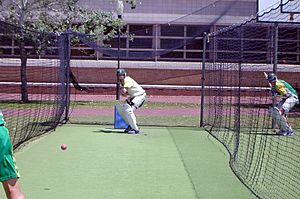
A pitch surrounded by netting, used for batting and bowling practice.
New Ball
In professional cricket, a new ball is used at the start of each innings. In timed matches, the fielding captain can take another new ball after 80 overs. New balls are harder and shinier.
Nick
Another term for edge or snick.
Nightwatchman
In first-class games, a lower order batter sent in late in the day to protect more skilled batters from getting out in dim light.
No
A batter's call to their partner to not run.
No-Ball
An illegal delivery. The batting side gets one extra run, and the bowler must bowl another ball. The batter cannot be dismissed by the bowler on a no-ball.
No Result
When a limited overs match cannot be completed due to things like rain, and neither team faces enough overs for a result.
Non-Striker
The batter standing at the bowling end, not currently facing the bowler.
Not Out
- A batter who is still batting and has not been dismissed.
- The umpire's call when they say a batter is not out.
Nurdle
To score runs, usually singles, by gently pushing the ball into empty areas of the field with low-risk shots.
Obstructing the Field
A very rare way a batter can be dismissed. It happens if they intentionally get in the way of a fielder trying to dismiss them.
Occupying the Crease
When a batter stays in for a long time, focusing on defence rather than scoring many runs. This can tire the bowler.
ODI
See One Day International.
Off Break
An off spin delivery that turns from the off side to the leg side for a right-handed batter.
Off Cutter
A cutter that turns from the off side to the leg side for a right-handed batter. It's the pace bowling version of an off break.
Off Side
The half of the pitch in front of the batter's body as they face the bowler. The opposite of leg side.
Off Spin
The spin bowling style produced by a right-arm finger spin bowler. The main delivery is an off break.
Off the Mark
When a batter scores their first run. If they get out without scoring, they "failed to get off the mark".
Off Theory
A fielding tactic where the bowler aims wide of the off stump and most fielders are placed on the off side to stop runs and get catches.
One-Day Cricket
A shorter form of the game with one innings per team, usually with a limited number of overs, played over one day.
One Day International (ODI)
A match between two national teams, limited to 50 overs per innings, played over one day.
One Down
A batter who bats at number 3 in the batting order.
Opener
- An opening batter.
- An opening bowler.
Opening Batter
One of the two batters who start the innings. They face the new ball and the opening bowlers.
Opening Bowler
One of the two bowlers who start the innings with the new ball. They are usually the fastest bowlers.
Orthodox
- Shots played in the correct, "textbook" way.
- See left-arm orthodox spin.
Out
- When a batter has been dismissed.
- The word the umpire says while raising their finger to signal a dismissal.
Outswing
A delivery that curves away from the batter in the air.
Outfield
The part of the field outside the 30-yard circle, further from the wickets.
Over
The delivery of six legal balls by one bowler.
Over the Wicket
When a bowler runs up to bowl on the side of the stumps that is closer to the batter. The opposite of around the wicket.
Overarm
The normal bowling action where the arm swings over the head without bending the elbow. This is the only type of bowling allowed in official matches.
Overpitched Delivery
A delivery that bounces too close to the batter but isn't a yorker. It's easy for the batter to hit.
Overthrows
Extra runs scored because a fielder makes a bad throw.
Pads
Protective gear for batters and wicket-keepers that covers their legs.
Pad Away
To intentionally use the pads to deflect the ball away from the wicket, usually when there's no risk of LBW.
Paddle Scoop
A shot where the batter kneels and scoops the ball over their head or shoulder. It's risky but can score a boundary behind the wicketkeeper.
Pair
When a batter scores zero runs in both innings of a two-innings match. Also called "a pair of spectacles" (0-0).
Partnership
The number of runs scored by two batters together before one of them gets dismissed.
Part-Time Bowler
A specialist batter (or wicket-keeper) who bowls occasionally to offer variety to the attack.
Pavilion
[[multiple image|width=thumb|direction=vertical|image1=Cricket Pavillion (48091497876).jpg|image2=Lords (5967623947).jpg|footer=Two examples of cricket pavilions: a small pavilion used in club cricket, and the much larger Lord's Pavilion.]] A building at the cricket ground that has the players' dressing rooms.
Peach
An unplayable delivery from a fast bowler, so good that the batter can't even edge it.
Perfume Ball
A bouncer that passes very close to the batter's face, so close they could supposedly smell it.
Pick
When a batter correctly identifies what type of delivery a bowler (especially a spinner) has bowled.
Pink Ball
A type of ball used in day/night timed matches because it's easier to see under floodlights than a red ball.
Pitch
- The rectangular surface in the middle of the field where most of the action happens. It's 22 yards long.
- When the ball bounces before reaching the batter.
- The spot where the ball bounces.
Pitch Up
To bowl a delivery on a fuller length.
Pitch Map
A diagram showing where a bowler's deliveries have bounced on the pitch.
Placement
When the ball is hit so that it goes between fielders, often resulting in a four.
Platinum Duck
When a player is dismissed for zero runs without facing a ball at all, usually by being run out.
Play and Miss
When a batter tries to hit the ball but doesn't make contact.
Playing On
When the batter hits the ball with their bat but it deflects onto the stumps, resulting in them being bowled out.
Plumb
- An LBW dismissal that is very clear and obvious.
- A wicket that gives a true, predictable bounce.
Point
A fielding position on the off side, at a right angle to the batter.
Popping Crease
A line four feet in front of the stumps. Batters must have their bat or body touching the ground behind this crease to be safe from a run out or stumping.
Powerplay
Special overs in limited overs matches where the batting side has a temporary advantage due to fielding restrictions.
Pull
A shot played to the leg side to a short-pitched delivery, usually between mid-wicket and backward square-leg.
Push
A batter's call for a run, encouraging their partner to try for two.
Put Down
- To put down the wicket (break it).
- To drop a catch.
Quarter Seam
A flush join between pieces of leather on the ball's surface, at right angles to the main stitched seam.
Quick
- Traditionally, a bowler who bowled their over quickly.
- More recently, a synonym for a fast or pace bowler.
Quick Single
When two batters run very fast between the wickets to score one run.
Quota
The maximum number of overs a bowler can bowl in a limited overs match.
Rabbit
A very poor batter, usually a specialist bowler, who is expected to get out cheaply.
Rain Delay
When play stops because of rain.
Rain Rule
Any method used to decide the winner of a one-day match that is shortened by rain, like the Duckworth-Lewis method.
Red Ball
The traditional type of ball, dyed red. Used in most timed matches and amateur games.
Referral
When a decision is sent to the third umpire for review using the Umpire Decision Review System.
Release
The exact moment a bowler lets go of the ball.
Required Run Rate
The run rate a team needs to score to win in the second innings of a limited overs match.
Reserve Day
An extra day set aside to replay or continue a match that was stopped by rain.
Rest Day
A non-playing day in the middle of a multi-day game. These are rare now.
Result
The final outcome of a match: a win/loss, a draw, or a tie.
Retire
When a batter voluntarily leaves the field during their innings, usually due to injury.
Reverse Sweep
When a right-handed batter plays a sweep shot like a left-handed batter, and vice versa.
Reverse Swing
When the ball swings in the opposite direction to how it normally would. This usually happens with an older ball that is worn on one side.
Review
See referral.
Rib Tickler
A short-pitched ball that bounces higher than expected and hits the batter in the ribs.
Right Arm
Refers to a bowler who bowls with their right hand.
Right Hand
Refers to a batter who bats right-handed.
Road
A very hard and flat pitch that is good for batting.
Roller
A cylindrical tool used to flatten the pitch before or during play.
Rotate the Strike
To score singles whenever possible to make sure both batters are always facing deliveries and scoring runs.
Rough
A worn-down part of the pitch, often from bowlers' footmarks, where spinners can get more turn.
Round the Wicket
See around the wicket.
Roundarm Bowling
A bowling action where the bowler's arm is straight out to the side when they release the ball. This is legal.
Royal Duck
When a batter is dismissed for zero runs off the very first ball of the entire game.
Run
The basic unit of scoring. Batters score a run by running from one end of the pitch to the other. They can score multiple runs or hit a boundary (four or six).
Run Chase
When the team batting second tries to score enough runs to win the match.
Run Out
A way a batter can be dismissed. A fielder breaks the wicket while the batter is outside their crease and trying to score a run.
Run Rate
The average number of runs scored per over.
Run-Up
A bowler's approach or run before bowling the ball.
Runner
A player from the batting side who runs between the wickets for an injured batter. Runners are not allowed in international cricket anymore.
Safe
When batters are in their ground and cannot be dismissed by a run out or stumping.
Scoreboard
[[multiple image|width=thumb|direction=vertical|image1=High Beach CC v Stansted CC at High Beach, Essex 125.jpg|image2=Headingley Cricket Ground- the scoreboard and the spire of St Michael and All Angels (geograph 1996113).jpg|footer=Two examples of scoreboards: a simple hand-operated scoreboard used in club cricket, and a large electronic scoreboard at Headingley Cricket Ground.]] A large display that shows the current score, wickets, overs, and other game information.
Scorer
The person who officially records the scores and detailed statistics of the game.
Scramble Seam
A seam bowling variation where the bowler makes the ball's seam tumble, hoping for unpredictable bounce.
Seam
- The raised stitching around the ball.
- When a ball changes direction after bouncing on its seam.
Seam Bowling
A bowling style that uses the ball's raised seam to make it change direction after bouncing.
Seamer
A seam bowler.
Season
The time of year when cricket is played.
Selector
A person who chooses players for a cricket team.
Sent In
When a team bats first after losing the toss, meaning the opposing captain chose for them to bat.
Series
A set of matches played between the same two teams in the same format, usually in different locations.
Session
A period of play during a day, like from the start to lunch, lunch to tea, or tea until stumps.
Shepherd the Strike
See farm the strike.
Shooter
A delivery that skids after bouncing, meaning it doesn't bounce as high as expected, making it hard to hit cleanly.
Short
- A fielding position close to the batter.
- A short-pitched delivery.
Short-Pitched
A delivery that bounces relatively close to the bowler, meant to bounce high (a bouncer).
Short of a Length
A short-pitched delivery that isn't as short as a bouncer.
Short Run
A run that doesn't count because one of the batters failed to touch the ground beyond the popping crease when turning for an extra run.
Shot
The act of the batter hitting the ball with their bat.
Shoulder Arms
When a batter lifts the bat high over their shoulder to avoid hitting the ball, usually to protect their wicket from a delivery they don't want to play.
Side On
- A bowler whose chest and hips face the batter when their back foot lands.
- A batter whose hips and shoulders face at 90 degrees to the bowler.
Sight Screen
A large board behind the bowler that provides a plain background, helping the batter see the ball.
Silly
A word added to fielding positions (like silly mid-off) to show they are unusually close to the batter.
Single
One run scored by the batters running once between the wickets.
Six
A shot that goes over or touches the boundary without bouncing, scoring six runs.
Skiddy
A pace bowler whose deliveries typically bounce low.
Skier
A shot that is hit almost straight up in the air. It usually results in the batter being caught out.
Skipper
An informal term for the captain.
Sledging
Verbal exchanges between players from opposing teams. It can be friendly banter or a way to try and upset the opponent.
Slog
A powerful shot where the batter hits the ball high and long to try and reach the boundary. It's risky but can score a six.
Slog Overs
See death overs.
Slog Sweep
A type of slog shot hit hard and high, usually against spin bowlers.
Slower Ball
A medium-pace delivery bowled by a fast bowler. It's meant to trick the batter into hitting too early.
Slow Left Armer
A left-arm, orthodox, finger spin bowler.
Snick
A slight deviation of the ball off the edge of the bat.
Snickometer
A TV graphic that uses sound to show if the ball touched the bat when reviewed.
Soft Hands (Batting)
Holding the bat loosely so it absorbs the ball's speed, making the ball drop gently.
Soft Hands (Fielding)
Catching the ball with relaxed hands to absorb its impact, reducing the chance of dropping it.
Specialist
A player chosen for the team mainly for one skill, like a specialist batter or specialist bowler.
Spectacles
Another word for a pair (0-0), because the zeros look like spectacles.
Spell
The number of continuous overs a bowler bowls before taking a break.
Spider Graph
A chart showing where a batter has scored runs with different shots, including direction and distance.
Spin Bowling
A bowling style where a spinner tries to trick the batter by making the ball spin using their fingers or wrist.
Spirit of Cricket
A concept of good conduct in cricket, including fair play, sportsmanship, and respecting umpires' decisions.
Splice
The joint between the bat's handle and blade. If the ball hits here, it often results in an easy catch.
Square
- A fielding position perpendicular to the pitch.
- The area in the middle of the ground where pitches are prepared.
Square Leg
A fielding position on the on side roughly at a right angle to the batter.
Stance
The batter's posture when holding their bat and facing a delivery.
Standing Up
The position a wicket-keeper takes, close to the stumps, when a slow bowler is bowling.
Start
When a batter successfully avoids getting dismissed for very few runs, usually meaning they've scored around twenty runs.
Sticky Wicket
A difficult, wet pitch.
Stock Ball
See stock delivery.
Stock Bowler
A bowler whose main job is to stop runs rather than take wickets.
Stock Delivery
A bowler's normal or most common type of delivery.
Straight Bat
The bat when held vertically or swung in a vertical arc.
Stranded
When a batter misses scoring a century or other milestone because their team's innings ends before they can reach it.
Strangled
When a batter tries to play a glance shot very fine to a leg-side ball, gets an inside edge, and is caught by the wicket-keeper.
Street
A pitch that is easy for batters and hard for bowlers.
Strike
The position of the batter facing the bowler. To "keep the strike" means to arrange runs so you face the first ball of the next over.
Strike Bowler
An attacking bowler whose main job is to take wickets, usually a fast bowler or attacking spinner.
Strike Rate
- (Batting) The number of runs a batter scores per 100 balls faced.
- (Bowling) The average number of deliveries a bowler bowls before taking a wicket.
Striker
The batter who is currently facing the bowler's deliveries.
Stroke
An attempt by the batter to hit the ball.
Stump
One of the three vertical posts that make up the wicket.
Stumped
A way a batter can be dismissed. The wicket-keeper breaks the wicket with the ball while the batter is outside their crease but not trying to score a run.
Stumps
- The plural of stump.
- The end of a day's play in a multi-day match.
Substitute
A player who can replace another fielder on the fielding side if someone is injured. They cannot bat, bowl, or keep wicket.
Super Over
A method used to decide a winner if a limited overs match ends in a tie. Each team bats one more over.
Sweep
A shot played to a good length slow delivery. The batter kneels and "sweeps" the ball to the leg side.
Sweet Spot
The small area on the bat's face that gives maximum power when the ball is hit there. A shot hit here is "well timed".
Swing
A bowling style where the ball curves in the air. This happens because one side of the ball is polished and the other is worn.
Switch Hit
A shot where the batter changes their stance and grip (e.g., a right-handed batter becomes a left-handed one) during the bowler's run-up.
Tail
A common term for the lower order of a batting team, usually the bowlers who are not good batters.
Tail-Ender
A player who bats at the end of the batting order, usually a specialist bowler or wicket-keeper with poor batting skills.
Tampering
Illegally changing the cricket ball's condition, usually by the fielding team, to help their bowlers. This is against the rules.
Tape Ball
A homemade cricket ball made by wrapping a tennis ball in electrical tape. Common in informal games.
Target
The score the team batting last needs to score to win.
Tea
The second break during a full day's play in a timed match.
Test Cricket
The highest level of the sport. These are timed matches that last up to five days, with two innings per side, played between national teams.
Textbook Shot
A shot played by the batter with perfect, traditional technique.
Third Man
A fielding position behind the wicket-keeper on the off-side, beyond the slip and gully areas.
Third Umpire
An umpire who sits off the field with a TV monitor. The on-field umpires can ask for their help to review decisions.
Through the Gate
When a batter is bowled by a ball that passes between their bat and pads before hitting the wicket.
Throwing
An illegal bowling action where the bowler straightens their arm during the delivery. Also called chucking.
Tie
When both teams' scores are equal at the end of a match, and the team batting last is all out or has played all their overs. Not to be confused with a draw.
Tied Down
When a batter or batting team has their run-making restricted by the bowling side.
Timber
A slang term for the stumps. To "hit the timber" means to get a bowled dismissal.
Timed Match
A match whose length is based on a set amount of time (e.g., three or five days) rather than a set number of overs. A draw is a possible result.
Timed Out
A way a batter can be dismissed if they don't come to the crease within a set time after a wicket falls.
Timing
The skill of hitting the ball so it strikes the bat's sweet spot. A "well-timed" shot feels easy but sends the ball very fast.
Ton
See century.
Top Edge
When the ball hits the top edge of the bat when a batter plays a cross-bat shot.
Top Order
The batters who bat in the top 4 of the batting order. They are usually the most skilled batters on the team.
Top Spin
Forward rotation on the ball, making it speed up immediately after bouncing.
Toss
The coin flip at the start of a match to decide which captain chooses whether to bat or field first.
Tour
An organized trip for a team to play a series of matches away from home, often used for international teams.
Track
Another term for the pitch.
Trundler
A reliable, steady medium-pace bowler who is not especially good or bad.
Turn
- How a batter changes direction when running between wickets.
- The amount a spin ball changes direction after hitting the pitch.
Tweaker
An informal term for a spin bowler.
Twelfth Man
Traditionally, the first substitute player who fields when a player is injured.
Twenty20 (T20)
A short form of limited overs cricket where each team has one innings with a maximum of twenty overs.
Two
A batter's call for a probable two runs.
Umpire
An official who makes sure the laws are followed and makes decisions during play. Two umpires are on the field, and a third umpire helps with TV replays.
Umpire Decision Review System (DRS)
An official system where teams can challenge certain decisions made by the on-field umpires. The third umpire reviews the decision using technology.
Umpire's Call
The outcome of a DRS review if the evidence is not clear enough to overturn the original umpire's decision. The original decision stands.
Uncapped
A player who has never played at the international level.
Underarm
A bowling action where the arm swings in a downswing arc. This is now illegal in formal cricket.
Under-Spin
Backward rotation on the ball, making it slow down immediately after bouncing.
Unorthodox
- A shot played in a non-traditional, improvised way.
- A left-arm spin bowler who spins the ball with their wrist like a right-arm leg-spin bowler.
Unplayable Delivery
A ball that is impossible for the batter to deal with, implying the bowler's skill caused the dismissal.
Upper Cut
A shot played against a short ball or bouncer where the batter cuts above their head, sending the ball to the third-man area.
Uppish
A shot that gains a risky amount of height, making it possible for the batter to be caught.
Variation
Any delivery by the bowler that is not their normal stock ball. It's used to surprise the batter.
Vee
- A V-shaped area on the field in front of the batter, where most straight shots are played.
- The V-shaped joint between the bat's handle and blade.
Village
An adjective meaning amateurish, often used negatively if applied to professional play.
Village Cricket
Amateur cricket, especially in England, where players are often from a single village. The standard of play is lower than club cricket.
Waft
A loose, uncommitted shot, usually played to a ball that is short of a length and wide of the off stump.
Wag
When the tail (lower order batters) scores more runs than expected.
Wagon Wheel
A graphic that shows how many runs a batter has scored with shots into different areas of the field.
Wait
A batter's call that delays the decision to run for a few seconds, used when it's unclear if a fielder will reach the ball.
Walk
When a batter leaves the pitch knowing they are out, without waiting for the umpire's decision. This is seen as good sportsmanship.
Walking Wicket
A very poor batter, especially a tail-ender, who is usually a specialist bowler.
Wash Out
A cricket match or a day of play that is stopped or cancelled due to rain.
Wearing Wicket
A turf pitch that becomes rough and abrasive as play continues, making it more helpful for spin bowling.
White Ball
A type of ball introduced for day/night matches because it's easier to see under floodlights. Used in all professional limited overs matches.
Whites
The traditional white or cream-colored clothing worn by players in matches with a red ball.
Wicket
- A set of stumps and bails.
- The pitch.
- The dismissal of a batter.
Wicket-Keeper
The player on the fielding side who stands right behind the batting end wicket. They are the only fielder allowed to wear gloves and leg guards.
Wicket-Keeper-Batter
A wicket-keeper who is also a very good batter.
Wicket Maiden
A maiden over where the bowler also takes a wicket.
Wicket-to-Wicket
An imaginary line connecting the two wickets, also a style of straight bowling.
Wickets in Hand
The number of wickets a batting side still has left in their innings.
Wide
A delivery that passes illegally wide of the wicket, scoring an extra run for the batting side. The bowler must bowl another ball.
Wisden
A famous cricket reference book published every year since 1864, often called the "Bible of Cricket".
Women's Cricket
Cricket played by women's teams. The rules are almost the same as men's cricket.
Worm
A graph that shows a team's total runs or run rate against the over number in limited-overs cricket.
Wrist Spin
A type of spin bowling where the ball is made to spin using the bowler's wrist.
Wrong 'Un
Another name for a googly.
Yips
A psychological condition where a bowler loses confidence and struggles to release the ball correctly, affecting their flight, turn, and accuracy.
Yorker
A delivery (usually fast) that is pitched very close to the batter, aiming for the block hole (under the bat or on the toes). A perfect yorker is very hard to hit.
Zooter
A variation of the flipper bowled by a leg-break bowler. It supposedly travels along the ground with little bounce.
Images for kids
-
Young Cricketer. "Yes, I cocked one off the splice in the gully and the blighter gathered it."
Father. "Yes, but how did you get out? Were you caught, stumped or bowled, or what?"
Cartoon from Punch, 21 July 1920. -
Bowler Mashrafe Mortaza appeals for a wicket during the 2015 Cricket World Cup.
-
Bowler Darren Gough winds up to deliver a ball.
-
The blue cap of England
-
The baggy green of Australia
-
A day/night match, between Australia and South Africa at The Gabba in 2006
-
Shaun Pollock in the nets
-
The much larger Lord's Pavilion.


